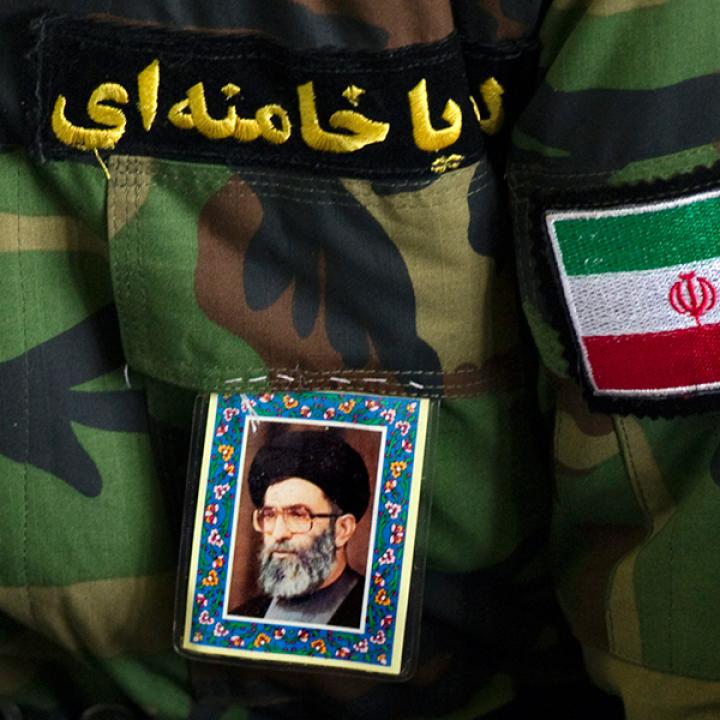
- Policy Analysis
- PolicyWatch 2477
Maximal Exposure, Minimal Presence: Iran's Military Engagement in Iraq

Funeral notices and other information on Iran's combat fatalities in Iraq provide a useful window into Tehran's military strategy there, especially compared to its differing approach in Syria.
Although Iran's Islamic Revolutionary Guard Corps-Qods Force (IRGC-QF) and its commander, Maj. Gen. Qasem Soleimani, remain involved in Iraq, the actual scope of their military engagement seems inversely proportional to the intense Iranian social media and press coverage of their operations there. A survey of Persian-language reports on funeral services for Iranian nationals killed in combat in Iraq testifies to this. The past year marked the peak of Iranian social media coverage of IRGC-QF operations in Iraq, but only twenty-six Iranian nationals were killed in combat there over this period. In contrast, Iranian social media largely ignored IRGC-QF operations in Syria despite the much higher combat fatality count there over the same period, which included seventy-six Iranians and numerous foreign Shiite fighters overseen by Qods Force personnel (eighty Afghans and twenty Pakistanis).
The difference in media coverage may be due to the varying degrees of popular support for operations in Iraq and Syria. Few Iranians seem to back their country's military engagement on behalf of Syria's Assad regime, whose use of chemical weapons was condemned in August 2013 by Ayatollah Akbar Hashemi Rafsanjani, chairman of Iran's Expediency Council. In contrast, the public seems undivided in its support for the struggle against the "Islamic State"/ISIS, whose barbaric and manifestly anti-Shiite behavior in Iraq has caused great anger in Iran.
By providing detailed information on the "heroic deeds" of the IRGC-QF, Soleimani, and fallen Iranians, the Islamic Republic propaganda machine is clearly rallying the public around the regime. This information also provides important insights into Tehran's military engagement in Iraq.
First, all twenty-six of the known Shiite combat fatalities in Iraq since July 2014 were Iranian nationals. Absent are Shiite Afghans, who have reportedly suffered heavy casualties in Syria.
Second, cemeteries in Iran's western provinces bordering Iraq are statistically overrepresented in hosting the earthly remains of these combat casualties. Six of the fighters killed were buried in Khuzestan province, two in Kermanshah, and one in Kurdistan. And in other cases, the families of fighters from these provinces likely sought to inter them not in their hometowns, but rather in the Behesht-e Zahra war cemetery in Tehran or at the major Shiite pilgrimage sites in Mashhad, Razavi Khorasan, and Qom. This statistical overrepresentation is hardly surprising: most Iranians from Khuzestan can speak Arabic, while natives of Kurdistan and Kermanshah have mastered different Kurdish dialects, all of which are particularly useful in commanding paramilitary forces in Iraq.
Third, all twenty-six of the Iranians killed were serving in the IRGC at the time. One served with the IRGC Air Force, and another with an IRGC special operations team. Three others were clearly identified as IRGC-QF members, and four served in the Basij Resistance Force. No specific branch was given for the remaining seventeen casualties, which may reflect an attempt to obscure their service in the elite Qods Force.
In addition, nine of the fallen Iranians were officers: one brigadier general, two colonels, one captain, and a former regional Basij "command council member" were identified, and four others were commemorated as sardar (commander). The remaining seventeen fatalities seemed to be specialists rather than mere foot soldiers, including two clerics, two engineers, and a photographer.
Although these relatively high ranks partly reflect the IRGC's tradition of posthumously promoting its "martyrs," they also indicate that Iranian nationals are serving in command positions at the helm of Iraqi Shiite militias. Reports on the work of Iranian officers and information about the time and place of their death reinforce that impression. Brig. Gen. Hamid Taqavi, by far the most important IRGC-QF fatality, served as one of the main organizers of Iraqi Shiite resistance to ISIS. Javad Jahani (a.k.a. Hosnavi) served as a shock troop unit leader, and the Iraqi militia under his command liberated Balad in Salah al-Din governorate. Jasem Nouri liberated Dujail, another town in Salah al-Din, while commanding a contingent of paramilitaries from Iraq's Popular Mobilization Units.
One reason why the Islamic Republic's propaganda machine has been so insistent on highlighting the bravery of fallen IRGC "heroes" in Iraq is because of what happened during the battle for Tikrit, Salah al-Din's provincial capital, in March-April of this year. Through fierce resistance, ISIS managed to bring the advancing Iraqi government forces and Soleimani-led Shiite militias to a halt. Only after the American-led coalition's continuous airstrikes against ISIS positions did Tikrit fall back under Iraqi control. Tehran has consistently dismissed any coordination with the United States in Tikrit, and its propaganda efforts since then may be an attempt to deflect attention from its dependency on U.S.-led air support -- a particularly embarrassing chapter in the Islamic Republic's military engagement in Iraq.
CONCLUSION
The Islamic Republic's limited military engagement in Iraq should not be interpreted as a sign of flagging Iranian interest in that campaign. Rather, it reflects the different needs of Tehran's proxies in separate theaters. As opposed to Syria, Iraq has no shortage of motivated Shiite (and Kurdish) fighters to counter ISIS. What is needed are competent field commanders, whom Tehran is willing to supply in order to continue the war and maintain Iraqi Shiite dependence on Iran.
Ali Alfoneh is a senior fellow at the Foundation for Defense of Democracies.






